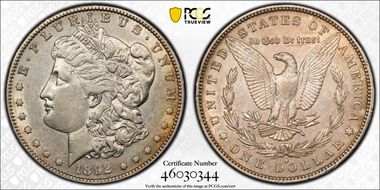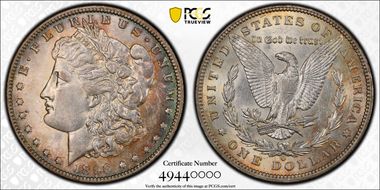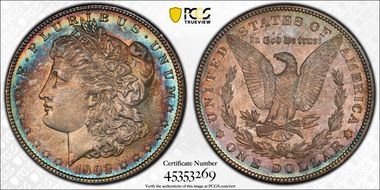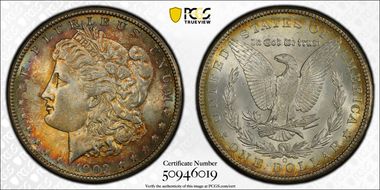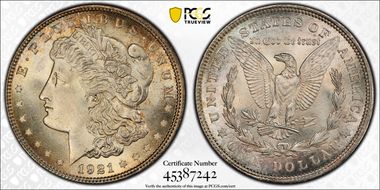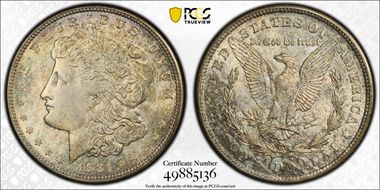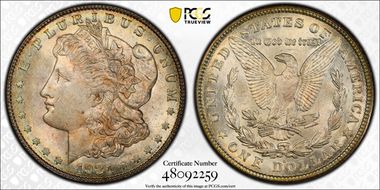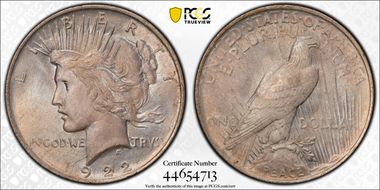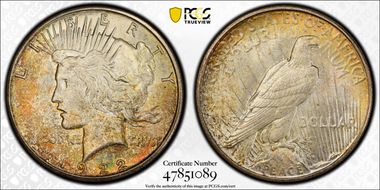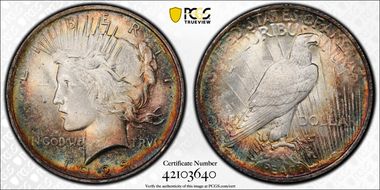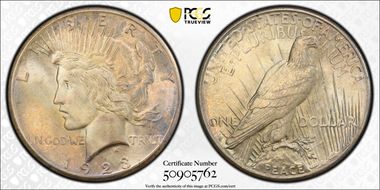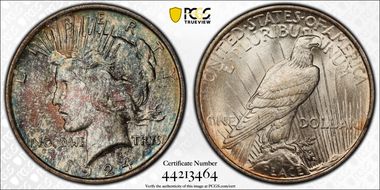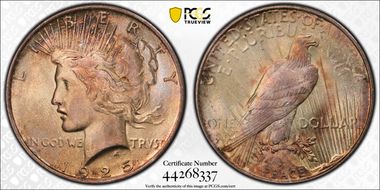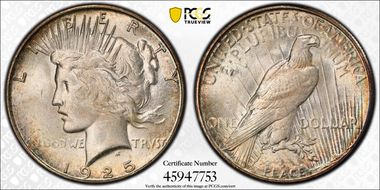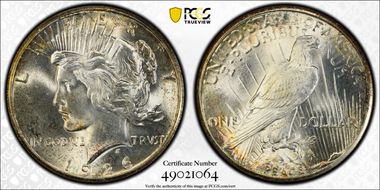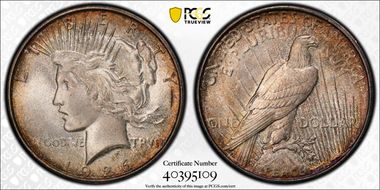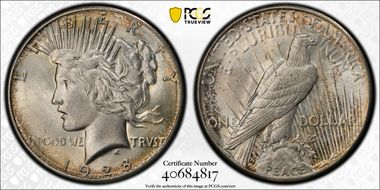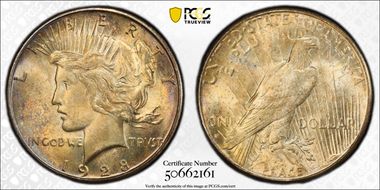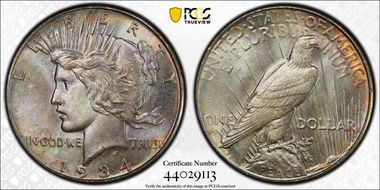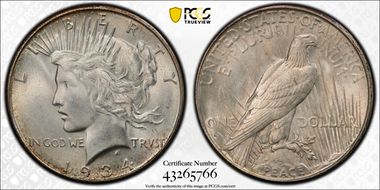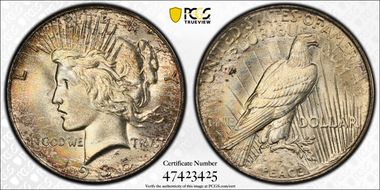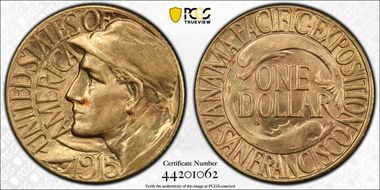Anablep 的钱币相册
CAC certified first year of issue, 1878 7/8 weak tail feathers with pastel colors evenly distributed on both the obverse and reverse.
Flashy olive and golden toned obverse and reverse of this CAC graded Morgan dollar.
Flashy olive and golden toned obverse and reverse of this CAC graded Morgan dollar.
Formerly in ANACS holder, this 1878 7 tail feathers dollar possesses elegant periphery toning in steel-blue and reddish-apricot which yields to lighter golden and silver in the center of the obverse. The bolder reverse is richly patinated throughout in a blend of steel-olive, reddish-gold, powder blue and salmon-pink. Crisply impressed, fully lustrous and exceptionally vivid near-gem Mint State preservation is found in this example of the desirable final design of 1878, the first year of Morgan dollar coinage.
Formerly in ANACS holder, this 1878 7 tail feathers dollar possesses elegant periphery toning in steel-blue and reddish-apricot which yields to lighter golden and silver in the center of the obverse. The bolder reverse is richly patinated throughout in a blend of steel-olive, reddish-gold, powder blue and salmon-pink. Crisply impressed, fully lustrous and exceptionally vivid near-gem Mint State preservation is found in this example of the desirable final design of 1878, the first year of Morgan dollar coinage.
Blue and brilliant on the obverse with a bulls eye blue, violet and gold on the reverse.
Blue and brilliant on the obverse with a bulls eye blue, violet and gold on the reverse.
Formerly in ANACS holder, this coin has some blue and orange toning around the edges of the obverse and reverse.
Formerly in ANACS holder, this coin has some blue and orange toning around the edges of the obverse and reverse.
Nice reflective fields on both the obverse and reverse with some rim toned blues and reds. Crossed over from ANACS MS65.
Nice reflective fields on both the obverse and reverse with some rim toned blues and reds. Crossed over from ANACS MS65.
Pleasing surfaces with warm russet and blue tone at the obverse rim and eye appealing red and golden at the reverse rim. The overall surfaces are particularly attractive for their luster.
Pleasing surfaces with warm russet and blue tone at the obverse rim and eye appealing red and golden at the reverse rim. The overall surfaces are particularly attractive for their luster.
Darker blue and orange toning covers both the obverse and reverse of this Carson City dollar sporting a rusted CC mint mark. The rusted version is often called the "Capped Die" or the "Capped CC." Of the two varieties, the non-rusted version is more common.
Formerly in ANACS holder, this coin has nice blue and orange toning around the edges of the obverse and reverse.
Formerly in ANACS holder, this coin has nice blue and orange toning around the edges of the obverse and reverse.
A flashy gem, rim toned in blue and purple, this Morgan was a crossover from an older ANACS holder.
A flashy gem, rim toned in blue and purple, this Morgan was a crossover from an older ANACS holder.
With a mintage of 12.6 million coins, the 1880-P Morgan is by no means a rare coin. However, it is not nearly as common in high grade as the San Francisco issue of the same year. The 1880-P is common through MS64, but becomes much harder to locate in gem. Vivid and varied iridescent overtones of orange-gold, antique olive and champagne-pink enliven a base of warm silver gray patina. This is a sharply struck and solidly graded gem dollar.
Nicely struck with heavy luster on the devices. Rings of blue and orange rim both the obverse and reverse.
Nicely struck with heavy luster on the devices. Rings of blue and orange rim both the obverse and reverse.
Rim toning in blue and orange surround the obverse devices while plum and violet fill 90% of the reverse of this MS64 graded coin. It is clear by the surviving population of 1880-O Morgan dollars that most of the 5.3 million coin mintage were released directly into circulation. Few were represented in the Treasury releases, which has made this coin exceptionally rare above MS64.
Rim toning in blue and orange surround the obverse devices while plum and violet fill 90% of the reverse of this MS64 graded coin. It is clear by the surviving population of 1880-O Morgan dollars that most of the 5.3 million coin mintage were released directly into circulation. Few were represented in the Treasury releases, which has made this coin exceptionally rare above MS64.
Ringed with blue, red and yellow, this gem Morgan dollar exhibits the classic album rim toned look.
Ringed with blue, red and yellow, this gem Morgan dollar exhibits the classic album rim toned look.
Ringed with blue, red and yellow, this gem Morgan dollar exhibits the classic album rim toned look. The reverse is frosty and proof-like. The 1880-S Morgan Dollar is one of the most common coins in the series. It is fairly easy to find up to MS66 condition.
Ringed with blue, red and yellow, this gem Morgan dollar exhibits the classic album rim toned look. The reverse is frosty and proof-like. The 1880-S Morgan Dollar is one of the most common coins in the series. It is fairly easy to find up to MS66 condition.
Wonderful wisps of silver stretch across predominantly orange-grey centers on the obverse, while concentric bands of red, orange, yellow, green, and blue radiate from the peripherals of this coin.
Wonderful wisps of silver stretch across predominantly orange-grey centers on the obverse, while concentric bands of red, orange, yellow, green, and blue radiate from the peripherals of this coin.
A rainbow of blues and reds frame lady Liberty above her head on the obverse of this clean and flashy Carson City Morgan dollar.
A rainbow of blues and reds frame lady Liberty above her head on the obverse of this clean and flashy Carson City Morgan dollar.
Formerly in ANACS holder, this coin has some blue, silver and orange toning around the edges of the obverse and reverse.
Formerly in ANACS holder, this coin has some blue, silver and orange toning around the edges of the obverse and reverse.
This fully superb gem, rim toned 1881-S looks as if it was struck yesterday. It is easily one of the nicest certified examples of this quintessential Morgan dollar date & mint combination. The 1881-S Morgan dollar is easily one of the most commonly encountered mint state Morgans today. By some estimations, perhaps a third of the original 12.7 million coin mintage exists today in mint state.
A flashy gem, rim toned in blue and purple on the obverse and PL on the reverse, this Morgan was a crossover from an older ANACS holder.
A flashy gem, rim toned in blue and purple on the obverse and PL on the reverse, this Morgan was a crossover from an older ANACS holder.
Album rim toning encircles the obverse and reverse in shades of blue and yellow.
Album rim toning encircles the obverse and reverse in shades of blue and yellow.
Bright, clean obverse, lustrous reverse. Some edge toning on both sides frames the devices of this nicely struck New Orleans issue. The 1882-O Silver Dollar is a common date but, because it comes from the New Orleans Mint, it is difficult to locate in Gem condition. The typical Mint State grade for an 1882-O Morgan Dollar is this grade, MS-63, reflective of the typical poor strike associated with this mint.
Bright, clean obverse, lustrous reverse. Some edge toning on both sides frames the devices of this nicely struck New Orleans issue. The 1882-O Silver Dollar is a common date but, because it comes from the New Orleans Mint, it is difficult to locate in Gem condition. The typical Mint State grade for an 1882-O Morgan Dollar is this grade, MS-63, reflective of the typical poor strike associated with this mint.
Lavender & orange toned areas on the obverse accent a clean, mark-free Liberty. The reverse is white.
Lavender & orange toned areas on the obverse accent a clean, mark-free Liberty. The reverse is white.
Described as "oyster shell" toning, this Morgan dollar has consistent golden and lavender toning on both the obverse and reverse giving it a skin of muted luster.
Described as "oyster shell" toning, this Morgan dollar has consistent golden and lavender toning on both the obverse and reverse giving it a skin of muted luster.
Blotchy, discontinuous toning on the reverse and obverse on this upgraded coin from MS64 ANACS to PCGS MS64+.
Blotchy, discontinuous toning on the reverse and obverse on this upgraded coin from MS64 ANACS to PCGS MS64+.
Rimmed with concentric rings of blue and orange, this New Orleans Morgan dollar exhibits a clean cheek and lacks distracting contact marks on all fields.
The 1883-S Morgan dollar is an issue that is usually well struck and high quality. However, the coins picked up many bag marks and abrasions due to years of improper storage in bags at the Treasury Department. Due to these abrasions, examples of this date are quite rare in the higher levels of mint state. This uncirculated San Francisco minted dollar displays tremendous luster, especially on the reverse, where a bright cartwheel flashes around full eagle breast feathers. The obverse possesses a subtle ring of orange toning around the devices.
Blue and russet album toning encircle the obverse and reverse exactly the way it should.
Blue and russet album toning encircle the obverse and reverse exactly the way it should.
Richly toned a pretty lavender-grey with stunning rainbow tints featured along the obverse rim and similar coloration more prevalent on the reverse of this New Orleans issue preserved in gorgeous premium gem condition.
This is quite a flashy rim toned coin with plenty of mint luster still present. Although the 1884-S Morgan dollar had a relatively healthy mintage of 3.2 million coins, it seems that most of those were released directly into circulation. This is evidenced by the extreme rarity of this issue in the mint state grades. As such, this AU example is a very worthy example, considering the cost-prohibitive price point of mint state 84-S Morgans.
Full rainbow of colors on the obverse starting at the rim and toward the center while a muted rainbow rims the reverse of this flashy dollar.
Full rainbow of colors on the obverse starting at the rim and toward the center while a muted rainbow rims the reverse of this flashy dollar.
Frosty gem Morgan dollar with a ring of gold on the obverse and a full rainbow of purple and orange glinting on the reverse.
Frosty gem Morgan dollar with a ring of gold on the obverse and a full rainbow of purple and orange glinting on the reverse.
Classic rim toning in blues, gold, and orange surround the edges of the obverse and reverse of this very clean MS67 Morgan dollar. The strike of this 1885-O dollars is better than average. Though it is more sharply struck than the vast majority of coins of this date, its luster is more greasy and less like a cartwheel. It replaces an MS64 that lacks the clean check and fields of this coin, but has better luster and equal rim toning.
Flashy luster and rings of blue & orange encircle the obverse and reverse.
Flashy luster and rings of blue & orange encircle the obverse and reverse.
This 1886 dollar is very well struck and has a more satiny or "greasy" luster rather than deeply frosty luster. With a light rim of orange color surrounding blast white devices, the eagle's breast feathers at the center of the reverse are nearly well-struck. The mintage of the 1886-P Morgan dollar is just under 20 million coins. While some were released at the time of striking, many survived untouched in original mint bags until the mid 20th century. Due to this, the 1886-P Morgan dollar is one of the most common in uncirculated grades today, with nearly 1000 equal in grade to this MS67 example. CAC approved.
Bold orange, violet, and blue surround the design on both the obverse and reverse of this CAC-certified, lower mintage S-mint coin. The San Francisco Mint produced the smallest number of silver dollars in 1886 of any year since the inception of the Morgan series. MS-64 coins are somewhat scarce and this issue is nearly always well struck.
Ridiculous orange toned centers with blue-silver rims on both the obverse and reverse, as both sides of the coin matches in color, luster and strike. The luster is a bit satiny or "greasy," on the dull side, rather than deeply lustrous and frosty, but the color more than makes up for the lack of flashy surfaces. The Philadelphia Mint struck over 20 million Morgan dollars in 1887.
Nice ring of blue and orange toning around the obverse and reverse of this New Orleans issue.
Nice ring of blue and orange toning around the obverse and reverse of this New Orleans issue.
Light peripheral toning around the date highlight this super clean S-mint coin. A real stunner.
Light peripheral toning around the date highlight this super clean S-mint coin. A real stunner.
Formerly in ANACS holder, this coin has moderate blue, plum and orange toning around the edges of the obverse and reverse.
Formerly in ANACS holder, this coin has moderate blue, plum and orange toning around the edges of the obverse and reverse.
A thick blue crescent adorns the obverse while peripheral rim toning highlights the reverse...
A thick blue crescent adorns the obverse while peripheral rim toning highlights the reverse...
The 1888-S is one of the scarcer Morgan dollars of its era. MS-64 1888-S dollars are scarce, with an estimated population of 3,000 to 5,000. This coin is frosty at the center with colorful rings of blue and orange toning along the rims.
Concentric rings of blue, orange and gold hem the obverse and reverse of the periphery of this clean MS64 Morgan dollar.
Concentric rings of blue, orange and gold hem the obverse and reverse of the periphery of this clean MS64 Morgan dollar.
Blue, orange and gold rim the obverse and reverse in a nearly continuous circle of color and flash on this CAC reviewed, nearly gem New Orleans Morgan dollar.
Blue, orange and gold rim the obverse and reverse in a nearly continuous circle of color and flash on this CAC reviewed, nearly gem New Orleans Morgan dollar.
Blue, orange and gold rim the obverse and reverse in a nearly continuous circle of color and flash on this CAC reviewed, nearly gem New Orleans Morgan dollar.
Blue, orange and gold rim the obverse and reverse in a nearly continuous circle of color and flash on this CAC reviewed, nearly gem New Orleans Morgan dollar.
This date is tough to find without bagmarks and scuffs. This example displays rim toning in blue and umber along the obverse and reverse. Liberty's cheek is clean. CAC approved...
This date is tough to find without bagmarks and scuffs. This example displays rim toning in blue and umber along the obverse and reverse. Liberty's cheek is clean. CAC approved...
Nice, sharply struck lustrous Carson City issue with light golden toning on the obverse surface.
Nice, sharply struck lustrous Carson City issue with light golden toning on the obverse surface.
Target rim toned in blue and ochre framing the obverse and reverse, especially on the left side of the coin. Typical mushy strike for this issue.
Target rim toned in blue and ochre framing the obverse and reverse, especially on the left side of the coin. Typical mushy strike for this issue.
Target rim toned in blue and ochre framing the obverse and reverse, especially on the left side of the coin. Typical mushy strike for this issue.
Rainbow toning rings the obverse while a deeper plum and orange mingles with the devices on the reverse.
Rainbow toning rings the obverse while a deeper plum and orange mingles with the devices on the reverse.
Most 1892-CC dollars are well struck. This nice AU rim toner still possesses tons of luster and flash. Although the mintage of the 1892-CC exceeded that of 1882-CC, 1883-CC, and 1884-CC, it is much more elusive in uncirculated grade, due to the relatively small amount of hoard coins remaining.
Since the striking quality is usually poor on the average 1892-O, with most surviving coins lightly struck over Miss Liberty's ear and lack of breast feathers on the eagle, this is a rather tough coin to find with a decent strike. In the hurry to coin as many dollars as possible with the smallest amount of effort, technicians at the New Orleans Mint spaced the dies too far apart. Among all Morgan dollars, the 1892-O is one of the most notorious for being flatly struck at the centers. This particular coin possesses a vibrant ring of blue and red, which frame the obverse in a typical target toned pattern, which is the object of each coin in this set.
Since the striking quality is usually poor on the average 1892-O, with most surviving coins lightly struck over Miss Liberty's ear and lack of breast feathers on the eagle, this is a rather tough coin to find with a decent strike. In the hurry to coin as many dollars as possible with the smallest amount of effort, technicians at the New Orleans Mint spaced the dies too far apart. Among all Morgan dollars, the 1892-O is one of the most notorious for being flatly struck at the centers. This particular coin possesses a vibrant ring of blue and red, which frame the obverse in a typical target toned pattern, which is the object of each coin in this set.
This evenly circulated coin shows flashes of AU level luster and enough peachy toning on both sides to merit an XF45 grade. Only 1.2 million 92-S Morgans were minted and many circulated coins of this date were melted in 1918 making it a scarce coin in the series.
Ring of Blue and orange surround the obverse devices on this AU Morgan dollar.
Ring of Blue and orange surround the obverse devices on this AU Morgan dollar.
Muted luster and toning on the obverse, flashy luster with muted orange on the reverse.
Muted luster and toning on the obverse, flashy luster with muted orange on the reverse.
The 1896 is the most common Morgan dollar of the 1890s and is plentiful in all circulation strike grades. Finding one with unique toning and a sharp strike at a high grade was important in making this purchase. This coin exhibits plum and aqua colors along the obverse while the reverse is blast white with strong breast feathers on the eagle. This coin has been stickered by CAC, designating agreement with PCGS's assessment of the coin's authenticity and grade.
Blue and orange circle both obverse and reverse of this typically flat struck but better-than-average in luster, AU Morgan dollar.
Nicely rim toned on both the obverse and reverse, this coin demonstrates the typical russet, blue and plum toning pattern of this series.
Nicely rim toned on both the obverse and reverse, this coin demonstrates the typical russet, blue and plum toning pattern of this series.
Blue rims highlight the obverse and reverse of this almost uncirculated New Orleans issue.
Nice peripheral toning with orange hues extending along the obverse and reverse rims.
Nice peripheral toning with orange hues extending along the obverse and reverse rims.
Originally in an ANACS MS64 holder, this lustrous, colorful Morgan dollar has upgraded to an MS65 holder.
Clean, rim toned Morgan dollar in orange and blue shows a New Orleans mintmark punched over a Carson City Mintmark. A common variety, but a fun issue nonetheless.
Clean, rim toned Morgan dollar in orange and blue shows a New Orleans mintmark punched over a Carson City Mintmark. A common variety, but a fun issue nonetheless.
Rim toning in blue and russet accents the obverse of this Morgan Dollar. This is a difficult date to find nicely toned.
Rim toning in blue and russet accents the obverse of this Morgan Dollar. This is a difficult date to find nicely toned.
Tough date Morgan dollar, this coin is toned with blue and orange fields on both the obverse and reverse.
Tough date Morgan dollar, this coin is toned with blue and orange fields on both the obverse and reverse.
Tough date Morgan dollar, this coin is toned with blue and orange fields on both the obverse and reverse.
Tough date Morgan dollar, this coin is toned with blue and orange fields on both the obverse and reverse.
Nice reverse rim toning in blue and gold. Minor planchet striations run horizontally across Liberty's cheek which are common for this issue.
Vibrant blue toning frames the more muted central areas of this gem Morgan dollar. Most uncirculated dollars of this date are satiny rather than deeply frosty.
Wonderfully original surfaces are toned in dominant rusty-silver and steel-blue patina, the deeper color at the peripheries. Under direct lighting, however, the color distribution reverses itself with light peripheral undertones of gold and powder blue giving way to rich mauve shades in the centers. Greasy luster is full and billowy throughout, and the strike is executed better-than-average, overall. The striking quality of most 1902-O dollars is usually poor, and some flatness is present at the center of the reverse.
Wonderfully original surfaces are toned in dominant rusty-silver and steel-blue patina, the deeper color at the peripheries. Under direct lighting, however, the color distribution reverses itself with light peripheral undertones of gold and powder blue giving way to rich mauve shades in the centers. Greasy luster is full and billowy throughout, and the strike is executed better-than-average, overall. The striking quality of most 1902-O dollars is usually poor, and some flatness is present at the center of the reverse.
The 1902-S is one of the scarcer San Francisco Mint entries in the Morgan dollar series, many of the 1,530,000 coins produced likely melted pursuant to the terms of the 1918 Pittman Act. Even so, thousands of Mint State examples came to light through government distributions from the 1920s through the early 1950s. Obtainable with relative ease in lower uncirculated grades, if still scarce by the standards of the type, the 1902-S remains a formidable condition rarity as an upper end Gem. This coin exhibits nice rim tones that are beginning to appear as golden orange tints on the obverse and reverse. CAC approved.
The 1902-S is one of the scarcer San Francisco Mint entries in the Morgan dollar series, many of the 1,530,000 coins produced likely melted pursuant to the terms of the 1918 Pittman Act. Even so, thousands of Mint State examples came to light through government distributions from the 1920s through the early 1950s. Obtainable with relative ease in lower uncirculated grades, if still scarce by the standards of the type, the 1902-S remains a formidable condition rarity as an upper end Gem. This coin exhibits nice rim tones that are beginning to appear as golden orange tints on the obverse and reverse. CAC approved.
Subtle toning on obverse along the rim on this circulated example of a tough S-mint dollar.
What this coin lacks in luster, it makes up for in color. Exhibiting deep plums, blues and pinks on both the obverse and reverse, the near-terminal toning of this coin pops when held at the correct angle in the light. Nicely struck and free of any marks on the cheek, this Morgan dollar is the rare exception to the rule for this date. Most coins of this issue have a subdued gray luster that is often dull and unattractive with poor to average stike at best. This coin demonstrates none of those characteristics. CAC approved.
What this coin lacks in luster, it makes up for in color. Exhibiting deep plums, blues and pinks on both the obverse and reverse, the near-terminal toning of this coin pops when held at the correct angle in the light. Nicely struck and free of any marks on the cheek, this Morgan dollar is the rare exception to the rule for this date. Most coins of this issue have a subdued gray luster that is often dull and unattractive with poor to average stike at best. This coin demonstrates none of those characteristics. CAC approved.
Blue rim toning is featured on the reverse of this Morgan Dollar while gold, russet and blue highlight the rim near Liberty's cap on the obverse.
Blue rim toning is featured on the reverse of this Morgan Dollar while gold, russet and blue highlight the rim near Liberty's cap on the obverse.
Nice AU example of a tough date with just a whisp of toning along the obverse rim above Liberty's portrait.
Nice AU example of a tough date with just a whisp of toning along the obverse rim above Liberty's portrait.
Most 1921 Morgan dollars are poorly struck and quite unappealing. This coin may be an exception. With light toning on the obverse and reverse and a decent, though typically shallow strike, this MS66 dollar is better looking than most other 1921s.
Flashy, clean, and colorful, this 1921-D Morgan is struck from redesigned shallow-relief dies though the surfaces are frosty and lustrous. Morgan had to recreate entirely new master dies for the 1921 issue, which explains why the 1921 Morgan dollars look very different from the earlier issues. Some 20.3 million Morgans were struck in Denver in 1921. Like the San Francisco and Philly issues, this was a record number that was never broken. Quality was better in Denver than San Francisco, and this issue is readily available in gem and above. The D mintmark is tiny on this coin, as is the case with all issues. CAC approved.
Nicely toned and brightly lustrous, this final dollar of the Morgan run is typically struck with abraded surfaces, with the high points of the design slightly bagmarked. Almost 21.7 million Morgans were struck in San Francisco this year, the most silver dollars ever struck in a year in San Francisco. The coins are very common today, but fully struck examples with good luster can be hard to locate. The coins are available in gem, but do bring a large premium to lesser quality coins. Overall, 65+ is a difficult grade to attain for this date and mint. CAC approved.
Nicely toned and brightly lustrous, this final dollar of the Morgan run is typically struck with abraded surfaces, with the high points of the design slightly bagmarked. Almost 21.7 million Morgans were struck in San Francisco this year, the most silver dollars ever struck in a year in San Francisco. The coins are very common today, but fully struck examples with good luster can be hard to locate. The coins are available in gem, but do bring a large premium to lesser quality coins. Overall, 65+ is a difficult grade to attain for this date and mint. CAC approved.
Dark toned, vibrant first year high relief Peace Dollar with dark blue and rose colored toning.
A hard, chrome-like surface with evenly distributed gunmetal gray tones on both the obverse and reverse highlight the clean surfaces of this high grade, common date Peace dollar.
Flashy & clean with blue streaks of toning along the rims of both obverse & reverse sides on this 64+ Peace dollar. The strike characteristics of the 1922-D are not as strong as on the P-Mints, and that tends to be true for an D-Mint Peace Dollar. However, fully struck examples are available and are worth a premium over softly struck coins.
A bright, orange toned, problem-free Peace dollar with clean surfaces, a full strike, and bold luster.
Exhibiting a stong strike and colorful eye appeal, this coin's luster is frosty white at the centers with a hard, metallic sheen of concentric colorful rings consisting of blues, reds, and greens surrounding the devices.
Light, even toning covers the obverse and reverse of this very bright and clean Denver issue.
Toned on both sides, this 1923-S is a better struck example of what is considered the worst struck coin of the Peace dollar series. The dies were spaced too far apart for most of the production run, and coins are often seen with light striking on both the obverse and reverse. This particular coin has luster beneath a dense layer of crusty toning to go along with decently struck central devices.
Toned on both sides, this 1923-S is a better struck example of what is considered the worst struck coin of the Peace dollar series. The dies were spaced too far apart for most of the production run, and coins are often seen with light striking on both the obverse and reverse. This particular coin has luster beneath a champagne layer of pink, peach and blue toning to go along with its well struck central devices.
Mottled blues, reds and oranges splash across the entire obverse while the reverse exhibits a hint of orange toning around the periphery from 9 to 3 o'clock.
Mottled blue, plum and orange fill the areas around the obverse portrait of Liberty while the reverse luster is washed over in champagne tones on this dollar, one of the scarcest issues of the early part of the Peace dollar series, and the rarest S-Mint coin up to this point in time.
Uncommonly rich and inviting toning in a Peace dollar, this striking Gem-plus is dressed in a warm champagne colored patina. Given the rarity and consequent cost of the 1925 in MS-67, this bold, lustrous and handsomely toned MS-66+ represents a fully struck, lustrous and eye appealing Peace dollar of extraordinary quality.
Nicely rim-toned, this date is one of the poorest struck coins of the Peace dollar issue, with a mintage of just over 1.7 million coins. With frosty, grainy luster, this coin exhibits light blue, orange and green highlights.
Not considered a common date coin, the 1926 Philadelphia issed Peace dollar usually comes well struck and brilliant. This coin possesses those qualities plus the added bonus of natural patina and toning, especially on the reverse. Frosty and lustrous, this coin is graded MS66, a lofty grade for this particular date, as there is a distinct drop-off in high grade coins after MS65.
This tougher Denver issue Peace dollar is beautifully represented with crisp central motifs and lettering artfully framed with gold and olive hues extending inward from the peripheries.
Nicely toned Peace dollar in blue and russet hues with more rim toning on the reverse and broken tones on the obverse.
This handsome piece exhibits warm reddish-orange and, to a lesser extent, powder blue peripheral toning on the obverse. The reverse is matching with more silver-grey toward the center, while full striking detail and smooth mint luster come readily to the fore on both sides. Visually appealing in a common date & grade with uncommon color, this early date Peace dollar issue has 848,000 total minted coins.
This AU dollar looks mint state, with no contact marks and plenty of muted luster. It is probably severely under graded but serves as an impressive placeholder coin for now. There are major quality problem with the Denver issues, and they are nearly impossible to find in the gem grades.
Flashy and original, this Peace dollar has bright luster on both sides with champagne toning throughout the obverse. Even higher level pieces are nearly always weakly struck, though that does not seem to be the case with this coin. It displays a fully struck reverse with sharp detail on the eagle's feathers and there are no marks or nicks on the central area. Rims that are sometimes weak are fully struck up. Bagmarks are usually not a problem with 1927-S dollars, and this coin is free of any distracting marks.
Orange and green toning frame the obverse rim of this exceptionally well preserved, low-mintage Peace dollar. Much better looking than the MS63 grade indicated on the holder.
Wayne Miller considered this to be one of the top three rarest dollars of this design in high levels of Mint State. Although the 1928-S Peace dollar has a mintage nearly 5 times as large as it's Philadelphia counterpart, the 1928-S is much rarer in higher grade. In fact, this issue is often seen with such weak strikes that grades of MS65 and above are almost three times rarer than the Philly issue, indicating that the 1928-S may be the most elusive Peace dollar at the MS-65 level. This coin has consistent, mottled blue and golden toning enveloping both the obverse and reverse. The strike is excellent, with only the slightest weakness in the center, barely limiting this coin to a 64+ grade.
This Philadelphia semi-key, with a mintage below 1 million, is well struck with nice luster. Being quite rare above gem, the attractive and even toning on both the obverse and reverse demonstrate the originality of the coin's surfaces. With only 243 graded in MS66 by PCGS and 83 graded at NGC at the same grade, the coin enjoys a sleeper status as one of the more difficult to obtain examples at this level of preservation.
Thick satiny luster adorns the obverse and reverse of this harder to find Denver issue. A patina of color shades the obverse rim while cooler, frosty color adheres to the reverse.
With a mintage of 1,576,000 this nicely struck and modestly toned Peace dollar possesses orange, yellow and green toning most on the obverse. Luster is satiny, rather than deeply frosty and the strike is better than decent, where Liberty’s hair and the eagle’s feathers on the center of the reverse are fully struck up.
Perhaps the quintessential Peace dollar from a grade viewpoint, this piece is well struck, has satiny luster, and includes colorful mottled toning that frames both the obverse and reverse of this 1,964,000 mintage Peace dollar. CAC approved examples such as this coin are always in high demand. This dollar has 4 rays of sunshine under the "ONE" on the reverse.
Well struck, gem Pan-Pac gold dollar with some orange toning along the neck and nose of the obverse canal worker's portrait.
Bright and golden, there are very few marks on either side of this Pan-Pac commemorative, of which only 6,749 pieces survive. Charles Barber designed the obverse using a mythological hippocampus to transport the allegorical female figure of Columbia across the water. Columbia carries a caduceus as a nod to the successful medical triumph over the yellow fever that afflicted many of the canal's builders. The reverse eagle was designed by George Morgan.
Bright and golden, there are very few marks on either side of this Pan-Pac commemorative, of which only 6,749 pieces survive. Charles Barber designed the obverse using a mythological hippocampus to transport the allegorical female figure of Columbia across the water. Columbia carries a caduceus as a nod to the successful medical triumph over the yellow fever that afflicted many of the canal's builders. The reverse eagle was designed by George Morgan.
Lustrous toned gold with blue-green highlights on both the obverse and reverse.
Lustrous toned gold with blue-green highlights on both the obverse and reverse.
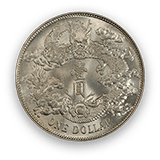
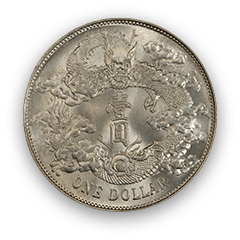
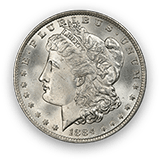








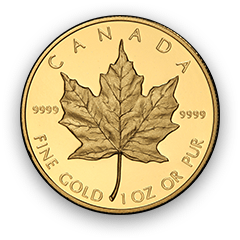








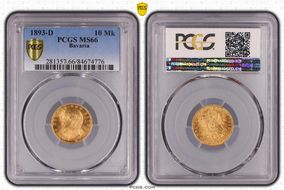
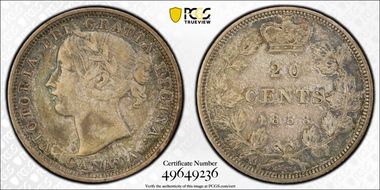
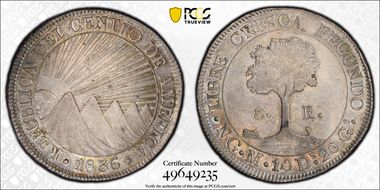
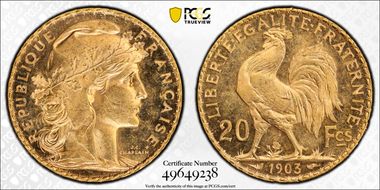
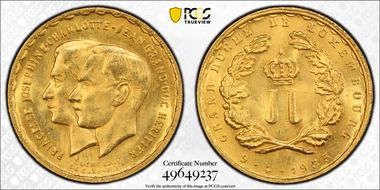
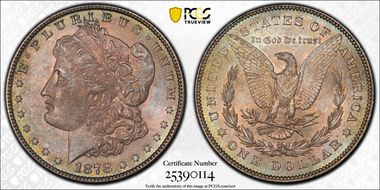














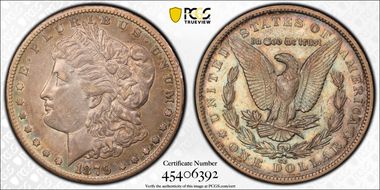




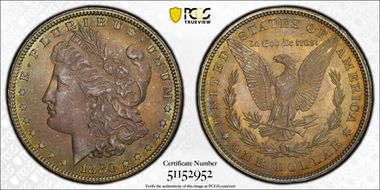






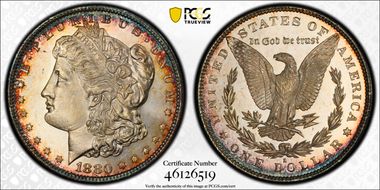







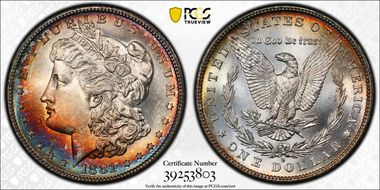












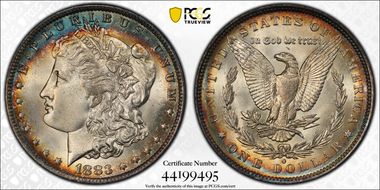
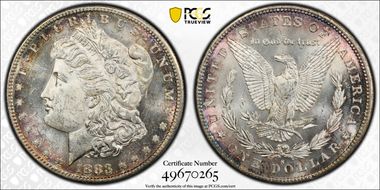




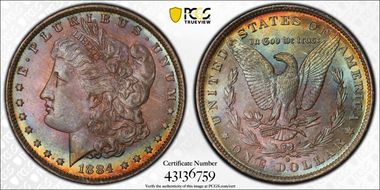
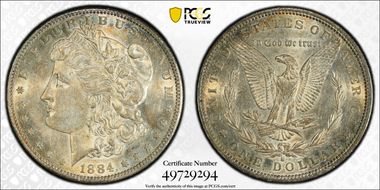




















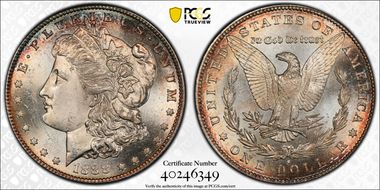


















_album.jpg)
_album.jpg)
